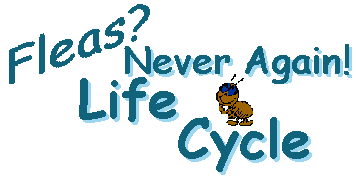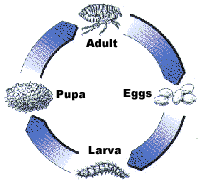
|


Flea Life Cycle and Habits
- Fleas pass through a complete life cycle
of four stages.
The flea population is typically
made up of 50% eggs,
30% larvae, 15% pupae
 and only 5% biting adults.
and only 5% biting adults.
|
- Completion of the life cycle from egg to adult varies
from two weeks to eight months.
- Normally the female flea lays
about 15 to 20 eggs per day up to 600 in a lifetime.
- Usual hosts for fleas are dogs, cats, rats, rabbits, mice, squirrels, chipmunks, raccoons, opossums, foxes, chickens, and humans.
- Eggs loosely laid in the
hair, drop out where the pet rests, sleeps or nests (rugs, carpets, upholstered furniture, cat or dog
boxes, kennels, sand boxes, etc.)
- Eggs hatch
in two days to two weeks
into larvae found indoors in floor cracks & crevices, along
baseboards, under rug edges and in furniture or beds.
Sand and gravel are very suitable for flea development
 which is the reason fleas are erroneously called "sand fleas."
which is the reason fleas are erroneously called "sand fleas."
|
- Outdoor development occurs in sandy gravel soils (moist sand boxes, dirt
crawlspace under the house, under shrubs, etc.) where the pet may rest
or sleep.
- Larvae are blind, avoid light, pass through three larval stages and take a
week to several months to develop.
- Their food consists of digested
blood from adult flea feces, dead skin, hair, feathers, and other
organic debris. (Larvae do not suck blood.)
- Pupa mature to adulthood
within a silken cocoon
woven by the larva to which pet hair, carpet
fiber, dust, grass cuttings, and other debris adheres.
- In about five
to fourteen days, adult fleas can emerge or may remain resting in the
cocoon until the detection of vibration (pet and people movement),
pressure (host animal lying down on them), heat, noise, or carbon
dioxide (meaning a potential blood source is near).
 Most fleas
survive the winter
Most fleas
survive the winter
in the larval or pupal stage
and grow best
during warm, moist winters and spring.
|
- Adult fleas cannot survive or
lay eggs without a blood meal, but may hibernate from two months to one
year without feeding.
- There is often a desperate
need for flea control
after a family has returned from a long vacation. The house has been
empty with no cat or dog around for fleas to feed on. When the family
and pets are gone, flea eggs hatch
and larvae pupate. The adult fleas
fully developed inside the pupal cocoon remains in a kind of "limbo"
for a long time until a blood source is near. The family returning
from vacation is immediately attacked by waiting hungry hordes of
fleas.
(In just 30 days, 10 female fleas under ideal conditions can
multiply to over a quarter million different life stages.)
Completely developed adult fleas can live for several months without eating,
as long as they do not emerge from their cacoons.

|
- Newly emerged adult fleas live only about one week if a blood meal is not
obtained.
-
Optimum temperatures for the flea's life cycle are 70°F
to 85°F and optimum humidity is 70 percent.
- Breaking the cycle with an
Insect Growth Regulator
, not just killing the few adults is the secret to flea control.
|

|
Start here!
~~ THE Solution ~~
Flea Products Index
Pet Treatments
House Treatments
Yard Treatments
Other Treatments
How to Order
Just click the Buy Button under each item that you want to
order. The automatic Shopping Cart
will help you all the way.
Home
"Add us to your
Favorites NOW"
dogs fleas pests insecticide Life Cycle of the flea pesticide kill fleas FLEAS DOGS cats CATS allergies allergy ALLERGIES ALLERGY
 dogs fleas pests insecticide Life Cycle of the flea pesticide kill fleas FLEAS DOGS cats CATS allergies allergy ALLERGIES ALLERGY
dogs fleas pests insecticide Life Cycle of the flea pesticide kill fleas FLEAS DOGS cats CATS allergies allergy ALLERGIES ALLERGY
dogs fleas pests insecticide Life Cycle of the flea pesticide kill fleas FLEAS DOGS cats CATS allergies allergy ALLERGIES ALLERGY
 dogs fleas pests insecticide Life Cycle of the flea pesticide kill fleas FLEAS DOGS cats CATS allergies allergy ALLERGIES ALLERGY
dogs fleas pests insecticide Life Cycle of the flea pesticide kill fleas FLEAS DOGS cats CATS allergies allergy ALLERGIES ALLERGY
dogs fleas pests insecticide Life Cycle of the flea pesticide kill fleas FLEAS DOGS cats CATS allergies allergy ALLERGIES ALLERGY
|

 dogs fleas pests insecticide Life Cycle of the flea pesticide kill fleas FLEAS DOGS cats CATS allergies allergy ALLERGIES ALLERGY
dogs fleas pests insecticide Life Cycle of the flea pesticide kill fleas FLEAS DOGS cats CATS allergies allergy ALLERGIES ALLERGY
 dogs fleas pests insecticide Life Cycle of the flea pesticide kill fleas FLEAS DOGS cats CATS allergies allergy ALLERGIES ALLERGY
dogs fleas pests insecticide Life Cycle of the flea pesticide kill fleas FLEAS DOGS cats CATS allergies allergy ALLERGIES ALLERGY

